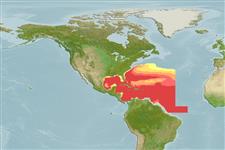>
Stomiiformes (Lightfishes and dragonfishes) >
Stomiidae (Barbeled dragonfishes) > Melanostomiinae
Etymology: Eustomias: Greek, eu = good + Greek, stoma = mouth (Ref. 45335).
More on authors: Regan & Trewavas.
Environment: milieu / climate zone / depth range / distribution range
Ecología
marino. Tropical
Western Atlantic: Straits of Florida, the northern Gulf of Mexico, the Bahamas, the Caribbean Sea, and off the northern coast of South America.
Tamaño / Peso / Age
Maturity: Lm ? range ? - ? cm
Max length : 14.5 cm SL macho / no sexado; (Ref. 37039)
Short description
Morfología | Morfometría
Radios blandos dorsales (total): 22-24; Radios blandos anales: 33 - 37. Body slender and elongate, color black; body depth 8-10% SL. Long, tapering, protrusible snout. Chin barbel moderately short, 18-41% SL. Barbel with slender stem and 2-4 terminal bulbs, with proximal (0.3-1.3% SL) and distal (0.6-2.1% SL) bulbs separated by a distance of 4-6.2% SL. Distal bulb bears terminal filaments 0.3-4.9% SL that either possess or lack swollen bulblets. Deep ventral groove absent. Pectoral rays free (Ref. 37039).
Life cycle and mating behavior
Madurez | Reproducción | Puesta | Huevos | Fecundidad | Larva
McEachran, J.D. and J.D. Fechhelm, 1998. Fishes of the Gulf of Mexico. Volume 1: Myxiniformes to Gasterosteiformes. University of Texas Press, Austin. 1112p. (Ref. 37039)
IUCN Red List Status (Ref. 130435)
Threat to humans
Harmless
Human uses
Más información
Nombres comunesSinónimosMetabolismoDespredadoresEcotoxicologíaReproducciónMadurezPuestaAgregación para la puestaFecundidadHuevosEgg development
Age/SizeCrecimientoLength-weightLength-lengthLength-frequenciesMorfometríaMorfologíaLarvaDinámica larvariaReclutamientoAbundanciaBRUVS
ReferenciasAcuiculturaPerfil de acuiculturaRazasGenéticaElectrophoresesheritabilidadEnfermedadesProcesamientoNutrientsMass conversion
ColaboradoresImágenesStamps, Coins Misc.SonidosCiguateraVelocidadTipo de nataciónSuperficie branquialOtolitosCerebrosVisión
Herramientas
Special reports
Download XML
Fuentes de Internet
Estimates based on models
Preferred temperature (Ref.
123201): 5.9 - 16.9, mean 10 °C (based on 248 cells).
Phylogenetic diversity index (Ref.
82804): PD
50 = 0.5000 [Uniqueness, from 0.5 = low to 2.0 = high].
Bayesian length-weight: a=0.00302 (0.00117 - 0.00783), b=3.12 (2.89 - 3.35), in cm total length, based on LWR estimates for this (Sub)family-body shape (Ref.
93245).
Nivel trófico (Ref.
69278): 4.2 ±0.8 se; based on size and trophs of closest relatives
Resiliencia (Ref.
120179): Alto, población duplicada en un tiempo mínimo inferior a 15 meses (Preliminary K or Fecundity.).
Fishing Vulnerability (Ref.
59153): Low vulnerability (10 of 100).
